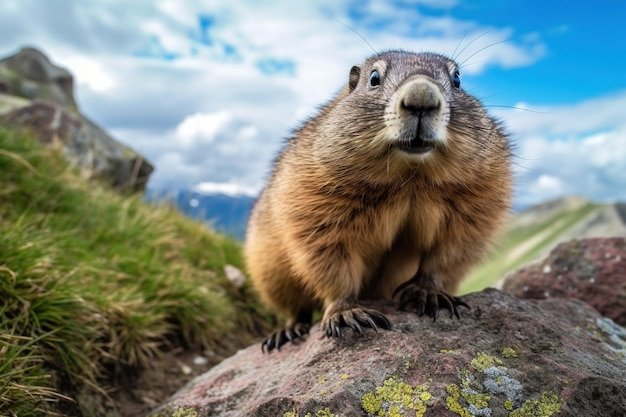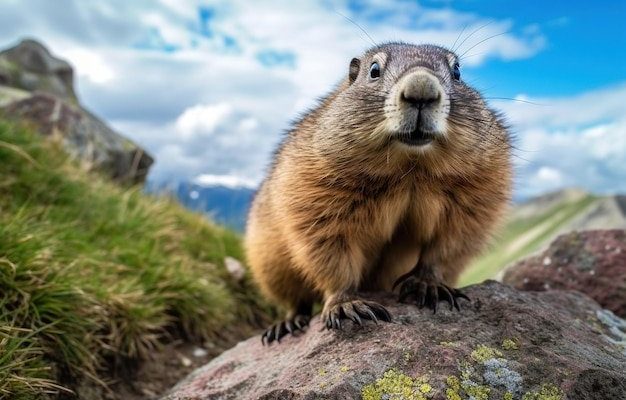
In this article, we’ll dive into the evolutionary history of the marmot, tracing its roots, adaptations, and how it fits into the greater family of rodents. You might be surprised to learn how these social animals interact with their environment and each other. So grab your favorite drink, and let’s explore the remarkable journey of the marmot!
The Marmot Family Tree
To understand the evolutionary history of the marmot, we first need to take a step back and look at the family tree. Marmots belong to the Sciuridae family, which includes squirrels, chipmunks, and prairie dogs. Imagine a big family reunion with all these furry relatives! Within this family, marmots are in the Marmota genus, consisting of about 14 species.
Marmots are primarily found in the northern hemisphere, especially in mountainous regions. They prefer habitats that allow them to dig burrows and find plenty of vegetation to munch on. The most well-known species, the groundhog, is celebrated for its weather-predicting talents. But each marmot has unique traits that help it thrive in its specific location.
Now, let’s zoom out a bit. The ancestors of modern marmots roamed the earth during the Oligocene Epoch, which lasted from about 34 to 23 million years ago. Fossil evidence shows that these early rodents were quite different from the marmots we see today. They were generally smaller and had different physical characteristics, but they laid the groundwork for the marmots we know and love.
Marmots Through the Ages
As we trace the evolutionary history of the marmot, we see how distinct species emerged and adapted over time. Each species evolved traits that allowed them to survive in various environments. For example, the yellow-bellied marmot, found in the Rocky Mountains, is known for its boldness and social behavior. They live in colonies, communicating with each other using a range of whistles and chirps.
In contrast, the Alpine marmot is a bit more reserved and thrives in the high altitudes of the Alps. Its thick fur and fat reserves prepare it for the harsh winters. This adaptability underscores an important point: evolution isn’t just about change; it’s about survival in different conditions.
Interestingly, studies suggest that the climate variations during different epochs played a huge role in shaping the marmot’s evolution. Adaptations to colder climates led to the development of thicker fur and an ability to enter a state of dormancy during winter months. These evolutionary changes reflect the remarkable resilience of the marmot throughout history.
The Social Structure of Marmots
You might be wondering how marmots interact with each other, given their varied habitats. Marmots are social animals, often living in groups called colonies, which can have anywhere from a few to over a dozen members. Living together provides numerous benefits, including better defenses against predators. Think of it like a neighborhood watch for these furry creatures!
In these colonies, you’ll often find a hierarchy. There are dominant individuals, typically the breeding pair, while other members help care for the young and maintain their burrows. This cooperative behavior enhances their survival and is a fascinating aspect of their evolutionary journey.
When it comes to communication, marmots have a *language* of their own. They use various calls to warn others of danger or to announce their presence. Just like gossip in a human community can spread important news, these vocal cues help keep the colony informed and safe.
Marmots have evolved some pretty interesting adaptations that help them thrive in their specific environments. One of the most notable features is their burrowing behavior. Marmots dig extensive tunnel networks that provide shelter from predators and harsh weather. These burrows are more than just homes; they serve as a safe space for raising young and hibernating during the winter.
Additionally, their diet plays a crucial role in their survival. Marmots are primarily herbivores, munching on grasses, flowers, and herbs. During the summer months, they eat as much as they can to build fat reserves. This is essential for their hibernation—imagine a long winter nap after a feast!
Their thick coats also provide insulation against cold weather. As the seasons change, marmots shed and grow fur to match the climate, showcasing their adaptability to both hot summers and frigid winters.
The Role of Marmots in Ecosystems
Marmots are more than just adorable creatures; they play a vital role in their ecosystems. By burrowing, they aerate the soil, which improves its quality. These actions help promote plant growth, benefiting not only themselves but also other species in the area. Plus, their burrows create habitats for various smaller animals, adding to the biodiversity of their environments.
Let’s not forget their role as prey. Marmots provide a food source for various predators, including eagles, foxes, and bears. This interconnected web of life highlights their importance in maintaining ecological balance.
Interestingly, studies have shown that the presence of marmot colonies can indicate the health of their ecosystems. When marmots thrive, it often means that the environment is resilient and supports diverse plant and animal life.
Conservation Status and Challenges
As with many species, marmots face challenges in the modern world. Habitat loss due to urban development, climate change, and human activities pose serious threats to their populations. Some species, such as the Olympic marmot, have seen significant declines, raising alarm among conservationists.
Conservation efforts are crucial to protect these remarkable animals. Many organizations work to preserve their habitats and educate the public about the importance of maintaining biodiversity. Additionally, research into their behaviors and ecology helps inform these efforts, ensuring that marmots continue to thrive in their natural environments.
It’s important to remember that we all play a part in the conservation of wildlife. Even small actions, like supporting local conservation initiatives or being mindful of our environmental impact, can make a difference.
Closing Thoughts
The evolutionary history of the marmot is a captivating story of adaptation, survival, and community. From their early ancestors to the charming critters we see today, marmots have overcome many challenges and continue to play a vital role in their ecosystems. By understanding their journey, we not only appreciate these remarkable animals more but also recognize the importance of preserving their habitats for future generations.
Next time you spot a marmot soaking up the sun, take a moment to think about its incredible evolutionary legacy and the vital role it plays in the natural world. After all, every creature has a story worth knowing, and marmots are no exception.

